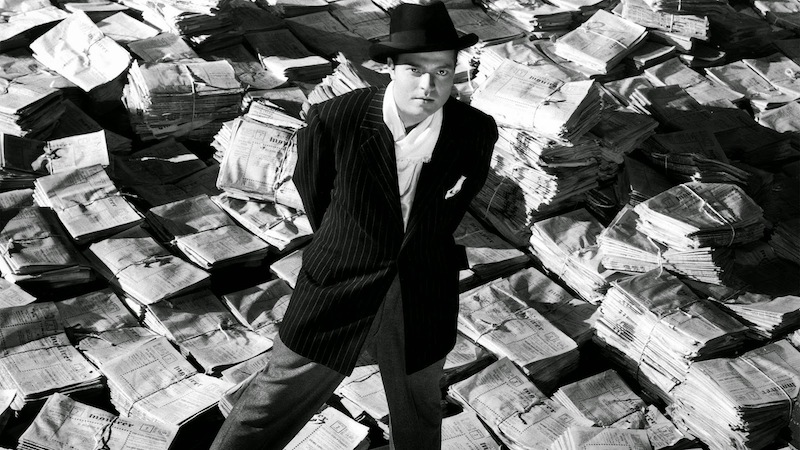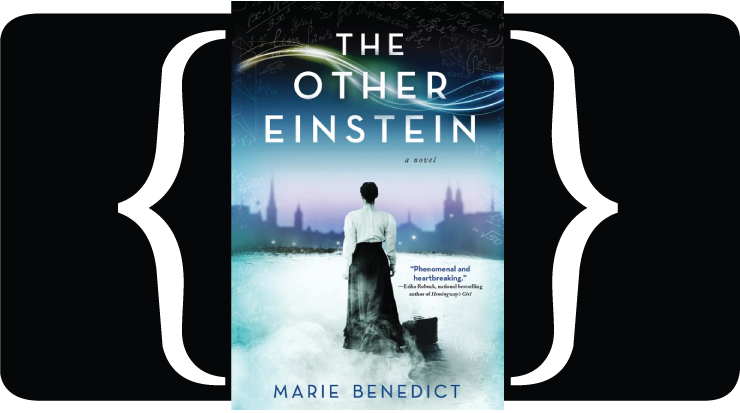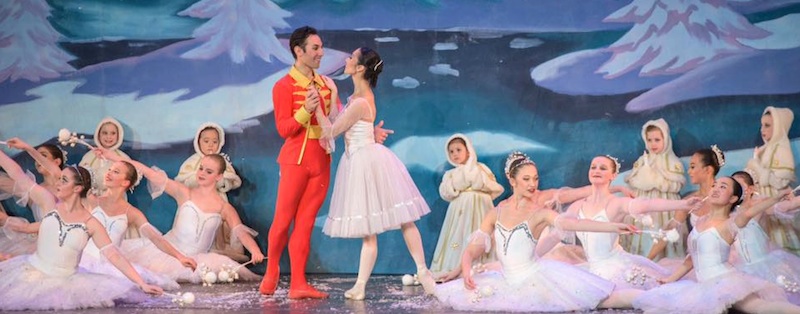Review: Purple Rose’s "Smart Love" asks big questions in family drama

What is a human being? Is a human a collection of parts, an accumulation of memories? A smile, a dance, a bundle of eccentricities?
These are a few of the questions pondered in Brian Letscher’s new comic drama Smart Love, being given its world premiere at Chelsea’s Purple Rose Theatre.
It’s a tightly focused family drama which is also a brainy sci-fi take on the limits of science and the consequences of going beyond those limits.
Double Acts: Theatre Nova's "Popcorn Falls" is full of comedic riffs

The new play Popcorn Falls is an energetic romp, full of impressions, wit, and (slightly manic) charm. Written by James Hindman and directed by Daniel C. Walker, Popcorn Falls features two men riffing off one another in the style of comedy duos like Laurel and Hardy or Abbott and Costello. The time breezes by as the actors take on fifteen different roles, bringing to life the citizens of an entire small town.
The play focuses on Ted Trundell (Jeff Priskorn), the mayor of Popcorn Falls, and his friend, Joe (Jonathan Jones). When Mr. Doyle -- also played by Jones, a grinch-like role similar to Mr. Potter from It’s a Wonderful Life but with the lilting accent of a villainous Jimmy Stewart -- tells the mayor that he plans to take over the town and turn it into a sewage treatment center unless they can successfully put on a play that the town agreed to many years earlier. Ted decides that he’ll do whatever it takes to save his home -- even writing and directing a play despite having practically no familiarity with theater whatsoever.
It's Showtime: Japanese Prints of Kabuki Theater from the Collection of the University of Michigan Museum of Art

There are only a handful of art exhibits of such sophisticated complexity that they can absorb the viewer’s attention for an indefinite amount of time. Japanese Prints of Kabuki Theater from the Collection of the University of Michigan Museum of Art is one of those treasures.
This display, mounted in the UMMA’s spacious second-story A. Alfred Taubman Gallery, represents a level of sophistication that could only truly be appreciated by two audiences: Those for whom these colorful prints were originally intended and subsequent experts who can identify the identity of the portraiture as well as the work’s iconography. The rest of us will have to take what we can get.
It doesn’t mean that one has to be an expert in Japanese theater or have an advanced degree in the history of that country’s culture to appreciate Japanese Prints of Kabuki Theater -- although it sure doesn't hurt. Rather, appreciating this imaginative display requires a unique kind of patience that will allow the show to open up to the viewer at its own pace and in its own way. But that seems to be the intent of kabuki all along.
No More Cakes in the Rain: Colson Whitehead at Lydia Mendelssohn Theatre

Bestselling author Colson Whitehead spoke in Ann Arbor on January 12 as part of U-M’s bicentennial celebration theme semester, but it wasn’t his first visit to Treetown. Apparently, in 2001, Whitehead gave a reading at Borders to “about five people,” on a night when the Red Wings were playing for the Stanley Cup.
“It seemed like a good excuse,” said Whitehead with a shrug –- this time, to a near-capacity crowd packed into Lydia Mendelssohn Theatre.
Whitehead now has many more published books and years of experience under his belt, of course. But his mainstream profile spiked most dramatically in the last few months, when the publication date of his newest novel, The Underground Railroad, got bumped up a month (from September to August) due to it being named an Oprah’s Book Club selection -- and nothing makes an author’s career explode quite like receiving Oprah’s imprimatur.
That’s far from Railroad’s only distinction, though. The novel also won the National Book Award for fiction and was named one of the best books of the year by The New York Times, The Washington Post, GQ, Newsday, and more.
Ann Arbor District Library 2016 Staff Picks: Books, Movies, Music & More

The Gregorian calendar rules most of the world, but time is a continuum. That's why our 2016 Ann Arbor District Library staff picks for books, music, film, and more include items that go back as far as 1865. Our list is comprised of media (and a few other things) that made an impact on us in 2016, no matter when the material came out.
Libraries have always acted as curation stations, helping sort through the vast amount of media released every year. On our website, we have more than 50 staff-curated lists of recommendations, but we don't just advocate for things digitally. We share our "picks" in person every time you step into the library. Books with prominent positions in our spaces, whether facing forward or on shelf tops, are chosen by staff members because they want you to pick up those pages.
Consider the massive post below featuring 55 books, 25 films and TV shows, and 20 albums -- plus a few odds and ends -- as a continuation of those curated lists, those forward-facing books, and the Ann Arbor District Library’s ongoing mission to bring high-quality art, entertainment, and information into your lives.
So, ready your library cards: Most of the recommendations below are in our collection; just click on the {[AADL]} link at the end of each pick to be taken to the item's page on our website.
A Deep Welles of Ideas: “It’s Still Terrific: Citizen Kane at 75”

Get over it: Citizen Kane is smarter than you. It’s smarter than any and all of us—or even its own creator, for that matter.
It’s smarter, because—if as has sometimes been said—the making of any movie is a miracle, then Citizen Kane is more than a miracle. It’s the Mona Lisa of film-making: inscrutable, ineffable, and unfathomable to whomever views it.
It’s also not a bad effort for a 25-year-old first time-out-of-the-chute theatrical amateur who by his own admission in the University of Michigan Harlan Hatcher Graduate Library’s It’s Still Terrific: Citizen Kane at 75 tells us that he had no real idea of what he was doing.
Indeed, as this exhibit at the U-M Hatcher Graduate Library Audubon Room illustrates through both sight and sound, it’s very likely the film is superior because enfant terrible Orson Welles didn’t know what he was doing. Which, of course, only makes the film that much more impressive.
Fabulous Fiction Firsts #623

In the same vein as fictional biographies such as Mrs. Poe by Lynn Cullen; The Paris Wife by Paula McLain; and Mrs. Engels by Gavin McCrea - in which intelligent women whose own aspirations and contribution were marginalized in favor of their spouses. Marie Benedict's debut gives us the story of Mileva Maric, a brilliant physicist and an extraordinarily gifted mathematician.
In 1896, before she was The Other Einstein, Mileva Maric´ was the only woman studying physics at Zurich Polytechnic and easily fell under the spell of a charismatic fellow student. Their courtship was kept secret not only due to the disapproval of the social-climbing Einsteins, but also for disappointing her father who held great hopes for her. An unplanned pregnancy, and failed qualifying exams sent Mileva home alone without any support from Albert.
Prêt-à-Potter: Avant Garden — Matthaei Botanical Gardens 2016

With the coldest temperatures of the year forecast for this week, you’ve surely noticed that winter has finally arrived in Ann Arbor.
If you’re not quite ready to accept the frigid temps or crunchy snow underfoot and are still in the denial about the transition to winter (which, by the way, officially arrives on Wednesday at 5:44 am EST), treat yourself to a visit to Matthaei Botanical Gardens for a respite in the lovely Conservatory, which is currently hosting the Avant Garden: Weaving Fashion and Nature Together exhibition. (Fun fact! Alden Dow designed the Conservatory in 1964, and he also designed the original part of the Downtown Library building at 343 S. Fifth Avenue.)
Avant Garden is a whimsical convergence of planting design and fashion design in the form of seven “fantasy outfits.” I asked Bob Grese, Professor of Landscape Architecture and Director of the Matthaei Botanical Gardens & Nichols Arboretum, about the exhibit and the use of plants in unexpected ways. He said, “The exhibit is a playful look at plants as a direct material for the fashion industry, with fantasy use of plants for dresses, vests, and suitcoats. Beyond the artistic use of plants in the exhibit, the real message is that we rely on plants for a variety of things in clothing—fibers, dyes, and representation on fabric patterns.” (Full disclosure: Grese was one of my professors in the Landscape Architecture program at U-M’s School of Natural Resources and Environment)
Part of the joy in this exhibit is wandering through the Conservatory to find each of the creations. The Conservatory is separated into three “Houses,” each replicating a different climate: Tropical, Temperate, and Desert. The dresses are thoughtfully placed within each of their respective garden spaces and the feeling of discovery and exploration is part of the exhibit experience. The shades of green and variety of textures in each of the plant selections bring richness to each design. Each dress has a different style, and all are charming and elegant. I particularly enjoyed the bromeliad dress, which comes complete with a fascinator hat.
Review: Academy of Russian Classical Ballet’s "The Nutcracker" at the Michigan Theater

This time of year some people need to hang lights, some people need to watch It’s a Wonderful Life and How the Grinch Stole Christmas? and some people need to attend a performance of The Nutcracker.
The ballet scratches a certain holiday itch with its familiar Tchaikovsky score and story of a Clara, a young girl who receives a nutcracker doll at her family’s Christmas party and, after a bit of magic, helps her now-human nutcracker prince defeat an army of giant mice. They celebrate by traveling through a snowstorm to the Kingdom of the Sweets where they are entertained by politically incorrect dances from faraway lands. All right, the plot isn’t its strong point, but a good Nutcracker hooks a certain segment of the population with its holiday appeal and lovely dancing.
As a member of that somewhat rarefied demographic, I went away satisfied from The Academy of Russian Classical Ballet’s production at the Michigan Theater on Saturday, December 10. I’m betting that the families there -- with children all dressed up and out past bedtime in a grand downtown theater -- also felt the itch scratched. It hit all the right notes with its convivial party scene and high-spirited dancing.
Review: Owen Gleiberman Discusses His Book, "Movie Freak: My Life Watching Movies

Nationally known film critic Owen Gleiberman appeared in his hometown -- specifically, the University of Michigan’s Harlan Hatcher Graduate Library Gallery -- on the evening of December 7 to talk about his book, Movie Freak: My Life Watching Movies.
Perhaps not surprisingly, Ann Arbor plays a key supporting role in Gleiberman’s story. Gleiberman moved to Treetown with his family when he was about five, and he grew up during the '60s and '70s -- which happened to be the heyday for U-M’s campus film societies. Gleiberman wrote about film while a student at Pioneer High, and he continued to do so for The Michigan Daily as a college student.
“I don’t know if i would have ever wanted to become a film critic, or a film buff, or everything this book is about if it hadn’t been for Ann Arbor, and the way this place kind of nurtured me,” Gleiberman said before reading a passage from his book on Wednesday night.
But in addition to chronicling his descent into movie madness, Movie Freak also, Gleiberman noted, turned out to be a kind of valentine to analog culture.


































